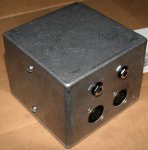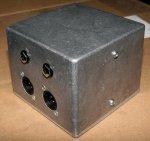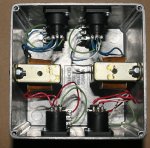I see most of the threads here involve speaker design, or other woodworking related topics. My interests generally run in the direction of metal bashing and soldering rather than sawing (sawdust is too messy :lol , so here's my contribution for what I hope is a useful isolation transformer design. Tom Manchester started a similar thread a while back, but I'm not sure if the project ever really got off the ground. Hopefully this will germinate some ideas for other members of the forum.
, so here's my contribution for what I hope is a useful isolation transformer design. Tom Manchester started a similar thread a while back, but I'm not sure if the project ever really got off the ground. Hopefully this will germinate some ideas for other members of the forum.
This project started with a clean-up around the shop, and a box of die cast Hammond cases that were in danger of being thrown out because no one remembered what they had been bought for. Being the pack rat that I am, I offered to give them a new home. I had previously salvaged some 1:1 transformers from an old MCI JH-636 studio console that had been parted out. I didn't have any specs on them, but they were fairly sizable, which is generally a good sign for transformers, and coming from an MCI, they were likely decent performers. The boxes were a little odd, in that they were almost cubic in their dimensions, but I figured I could fit two transformers and the associated connectors in each one, for a 2-channel isolation box.
One of the design goals was to make a box that could adapt between XLR, 1/4", balanced and unbalanced, and do it in either direction. I used Neutrik TRS jacks in parallel with the male and female XLRs, on all three contacts (T,R,S to 2,3,1). The transformer windings are connected to pins 2 and 3. Ground (pin 1) is not connected between input and output. Some people might put a switch in there, but I'm rather reluctant to do that because toggle switches are easily broken, can be set to the "wrong" position, and since this is an isolation box, lifted is generally what you want anyway. I had thought about putting a small value capacitor (0.01 µF) to provide an RF path between the grounds on either side of the box, and I may still do that.
The leads on the transformers had originally been connected to Molex connectors (an unfortunate trademark of MCI products), and were a bit on the short side, but with the mounting arrangement they just reached the XLR solder cups. 24 ga. stranded hookup wire was used to jump to the TRS jacks. The audio performance turns out to be pretty good. I did some quick checks with an Audio Precision Portable One (I'm not yet in the Smaart camp), and at +20 dBu, the distortion is good, even down in the 10-20 Hz range. Feeding it with a low source impedance, and into a high load impedance the frequency response was also virtually flat from 10-30 kHz. Some other transformers I've used for this in the past needed a damping resistance on the load (typically 5 kΩ) to avoid a bump around 10 kHz, but this was fine without it. I'll do a more comprehensive test if anyone is interested.
One thing I didn't test (and I'm not sure how you would spec such a thing) is the box's susceptibility to stray magnetic fields. I've had trouble with cheap wall warts in the past, making otherwise good DIs hum like crazy. These transformers don't seem to have any magnetic shielding, and the die cast aluminum case is impervious to fields, so that is a potential problem.
One other design feature I haven't yet decided on is how to label the thing. The cheap and dirty method would be P-touch labeling, which has been fairly durable for other items. Or I could spend about $40 per box and get them engraved, but it's a little hard to justify that when I've only spent about $8 (the cost of the connectors) plus sweat equity on each of them so far. Any experienced tech should recognize which jack is the input, although that may not be all that critical anyway with a 1:1 transformer. Any suggestions?
GTD



This project started with a clean-up around the shop, and a box of die cast Hammond cases that were in danger of being thrown out because no one remembered what they had been bought for. Being the pack rat that I am, I offered to give them a new home. I had previously salvaged some 1:1 transformers from an old MCI JH-636 studio console that had been parted out. I didn't have any specs on them, but they were fairly sizable, which is generally a good sign for transformers, and coming from an MCI, they were likely decent performers. The boxes were a little odd, in that they were almost cubic in their dimensions, but I figured I could fit two transformers and the associated connectors in each one, for a 2-channel isolation box.
One of the design goals was to make a box that could adapt between XLR, 1/4", balanced and unbalanced, and do it in either direction. I used Neutrik TRS jacks in parallel with the male and female XLRs, on all three contacts (T,R,S to 2,3,1). The transformer windings are connected to pins 2 and 3. Ground (pin 1) is not connected between input and output. Some people might put a switch in there, but I'm rather reluctant to do that because toggle switches are easily broken, can be set to the "wrong" position, and since this is an isolation box, lifted is generally what you want anyway. I had thought about putting a small value capacitor (0.01 µF) to provide an RF path between the grounds on either side of the box, and I may still do that.
The leads on the transformers had originally been connected to Molex connectors (an unfortunate trademark of MCI products), and were a bit on the short side, but with the mounting arrangement they just reached the XLR solder cups. 24 ga. stranded hookup wire was used to jump to the TRS jacks. The audio performance turns out to be pretty good. I did some quick checks with an Audio Precision Portable One (I'm not yet in the Smaart camp), and at +20 dBu, the distortion is good, even down in the 10-20 Hz range. Feeding it with a low source impedance, and into a high load impedance the frequency response was also virtually flat from 10-30 kHz. Some other transformers I've used for this in the past needed a damping resistance on the load (typically 5 kΩ) to avoid a bump around 10 kHz, but this was fine without it. I'll do a more comprehensive test if anyone is interested.
One thing I didn't test (and I'm not sure how you would spec such a thing) is the box's susceptibility to stray magnetic fields. I've had trouble with cheap wall warts in the past, making otherwise good DIs hum like crazy. These transformers don't seem to have any magnetic shielding, and the die cast aluminum case is impervious to fields, so that is a potential problem.
One other design feature I haven't yet decided on is how to label the thing. The cheap and dirty method would be P-touch labeling, which has been fairly durable for other items. Or I could spend about $40 per box and get them engraved, but it's a little hard to justify that when I've only spent about $8 (the cost of the connectors) plus sweat equity on each of them so far. Any experienced tech should recognize which jack is the input, although that may not be all that critical anyway with a 1:1 transformer. Any suggestions?
GTD




